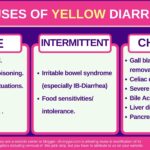Appendicitis Poop (smell, color, & form): Is there a link?
Our content is not intended nor recommended as a substitute for medical advice by your doctor. Use for informational purposes only.
1. Key points:
- Abdominal pain (in the right lower abdomen and around the umbilicus) is the most common symptom of appendicitis (often severe and progressive).
- Some patients may experience diarrhea or constipation with appendicitis.
- Also, Some patients may experience yellowish-colored diarrhea and an abnormal (foul) smell of poop with appendicitis.
- However, these changes are subtle and non-specific for appendicitis.
- The main feature of appendicitis is its characteristic pain.
- The diagnosis depends on visualizing the inflamed appendix using imaging techniques such as ultrasound and abdominal CT.
- White blood cell count also helps in its diagnosis (when elevated).
2. Appendicitis poop smell.
Appendicitis is a localized inflammation of the appendix (a small tube-like structure attached to the first part of your colon).
Typically, appendicitis may cause bowel irregularity (diarrhea or constipation), which can be confused with gastroenteritis.
There are no specific changes in poop smell in people with appendicitis. Although some patients may experience foul-smelling stool with appendicitis, it is not a unique disease feature.
Usually, poop becomes more offensive if there is an infection (gastroenteritis) or diseases altering digestion as food intolerances.
So, the fishy or foul-smelling stool doesn’t often mean appendicitis. A very offensive poop is more likely to be gastroenteritis or food poisoning than appendicitis.
Appendicitis is suspected when severe, progressive tummy pain around the umbilicus or in the right lower quadrant.
Diarrhea and abnormal stool smell may occur in the early stages of appendicitis. However, the symptoms are subtle and non-specific.
Unlike gastroenteritis, appendicitis pain starts vague and progresses to severe with intense tenderness in the right lower quadrant of the abdomen. Pain from gastroenteritis often lasts for a day or two and then improves rapidly.
You can learn more about the causes of foul or fishy-smelling diarrhea.
3. Appendicitis stool color.
Appendicitis patients may suffer from diarrhea (up to 33% of the cases). In addition, the speeding up gut content may cause yellow stool in patients with acute appendicitis and diarrhea.
However, the change is not specific and cannot be considered a (feature) of appendicitis stool. Any case of diarrhea may lead to lighter-colored stool (such as gastroenteritis, food intolerance, IBS, etc.). Hence, it is not a unique feature.
Also, most patients with acute appendicitis will have normal-colored (brown) stool without diarrhea.
Bloody (reddish) or blackish stool (melena) are NOT symptoms of acute appendicitis. However, red or black stool often means blood in the stool, as with peptic ulcer bleeding, diverticular diseases, and colon cancer.
4. Appendicitis & Bowel changes (constipation or diarrhea).
Appendicitis and diarrhea.
Diarrhea is a very common presentation for several diseases. For example, up to one-third of patients with appendicitis may present with diarrhea, especially at younger ages (reference).
Diarrhea may be a risk factor for severe or complicated appendicitis (reference). However, diarrhea may not be directly linked to severe appendicitis, as researchers proposed that diarrhea is often misdiagnosed as a gut bug.
The misdiagnosis of diarrhea as a sign of a gut bug (gastroenteritis) leads to delayed diagnosis of the condition giving more chance for complications to develop (reference).
Can you differentiate appendicitis diarrhea from other diarrheal diseases (such as gastroenteritis)?
Unfortunately, the differentiation is difficult as most cases of appendicitis-related diarrhea are almost identical in stool color, smell, and severity.
The only way you can suspect appendicitis based on diarrhea is the presence of typical appendicitis symptoms (especially characteristic abdominal pain).
The appendicitis pain is often way more severe and intolerable. Present around the umbilicus or in the right lower abdomen (the right iliac area).
Also, patients with appendicitis often have severe tenderness when touching their abdomen (especially the lower right quadrant area). Unlike gastroenteritis-related diarrhea, abdominal pain greatly increases when you move or cough with appendicitis.
Very offensive diarrhea is unlikely to be appendicitis because offensive diarrhea is usually due to gastroenteritis. However, there needs to be an accurate method of interpreting how much (offensive) stool smell is.
We’ve discussed the prevalence of diarrhea with appendicitis i
The table below illustrates the difference between appendicitis and gastroenteritis (reference).
| Appendicitis diarrhea (early stage) | Enteritis diarrhea | |
|---|---|---|
| 1. Abdominal pain Location | around the umbilicus, then shifts to the right. | Anywhere, mainly in the lower central abdomen |
| 2. Improvement of pain after defecation | No | Yes (partial or complete) |
| 3. Nausea onset | After the onset of pain. | Before the onset of pain |
| Fever | None or slight | None or slight |
| Pain on touching the abdomen (tenderness) | It may not present around the umbilicus in the early stages. | Mild or none. |
| Vomiting | in <50% of cases (children) | in >50% of patients (children) |
| Abdominal pain progression | -Increases over time | |
| -becomes more localized (lower right) | starts severe and often decreases over time. | |
| White blood cell count | often > 10000 | Often < 10000 |
Appendicitis and constipation.
A small percentage of people with appendicitis may present with abdominal pain and constipation (hard, difficult-to-pass stool).
Patients with constipation and appendicitis often have typical appendicitis pain and tenderness in the abdomen.
5. When to consider appendicitis.
The following is the typical scenario in appendicitis:
- It starts with mild abdominal pain around the umbilicus (belly button).
- Within hours, the inflammation of the umbilicus irritates the peritoneum over it (the peritoneum is a thin layer that envelopes most of the abdominal organs). The pain localizes in the lower right abdomen when the peritoneum becomes irritated.
- The pain starts mild and may come and go. Soon, it becomes more severe, constant, and localized.
- Nausea and anorexia follow the onset of pain (pain is the first sign).
- The pain doesn’t improve with defecation (unlike the pain from IBS and gastroenteritis).
- Severe tenderness and gardening over the area of pain.
- Fever (in 40% of the cases).
- Diarrhea or constipation (abnormal poop smell or color are NOT specific for appendicitis.
- Generalized fatigue (malaise).
- Sometimes, urinary frequency or urgency.
What are the mimics of appendicitis stool changes?
- Acute gastroenteritis (stomach flu and food poisoning): in such cases, nausea and diarrhea often precede the pain. After that, diarrhea and vomiting are more prominent. And the pain can occur where it is partially relieved by defecation.
- Irritable bowel syndrome.
- Mesenteric adenitis.
- Right renal colics.
- Inflammatory bowel diseases (Crohn’s commonly affects the right lower abdomen).
- Familial Mediterranean fever.
- Cecal diverticulitis.
- Right ovary pain (ovarian cyst, tumor, or portion) or right pelvic inflammatory disease.
- Right ectopic pregnancy, and others.
- Food intolerance attacks.
- Evidence-based
- Written by a doctor.






